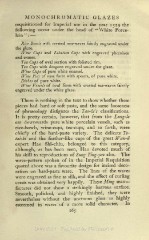Page 327 - Oriental Series Japan and China, Brinkly
P. 327
MONOCHROMATIC GLAZES
requisitioned for Imperial use in the year 1529 the
following occur under the head of " White Porce-
"
lain :
Rice Bowls with crested sea-waves faintly engraved under
the glaze.
Wine Cups and Libation Cups with engraved phoenixes
and cranes.
Tea Cups of oval section with foliated rim.
Tea Cups with dragons engraved under the glaze.
Wine Cups of pure white enamel.
Wine Pots of vase form with spouts, of pure white.
Dishes of pure white.
Wine Vessels of oval form with crested sea-waves faintly
engraved under the white glaze.
There is nothing in the text to show whether these
pieces had hard or soft paste, and the same looseness
of phraseology disfigures the Tao-lu's classifications.
It is pretty certain, however, that from the Lung-lo
era downwards pure white porcelain vessels, such as
rice-bowls, wine-cups, tea-cups, and so forth, were
chiefly of the hard-paste variety. The delicate 70-
tai-ki and the feather-like cups of the great Wan-li
expert Hao Shi-chiu, belonged to this category,
although, as has been seen, Hao devoted much of
his skill to reproductions of Sung Ting-yao also. The
wave-pattern spoken of in the Imperial Requisition
quoted above was a favourite design for incised deco-
ration on hard-paste ware. The lines of the waves
were engraved as fine as silk, and the effect of curling
crests was obtained very happily. These Ming manu-
factures did not show a strikingly lustrous surface.
Smooth, polished, and highly finished, they were
nevertheless without the unctuous gloss so highly
esteemed in wares of a more solid character. In
265

